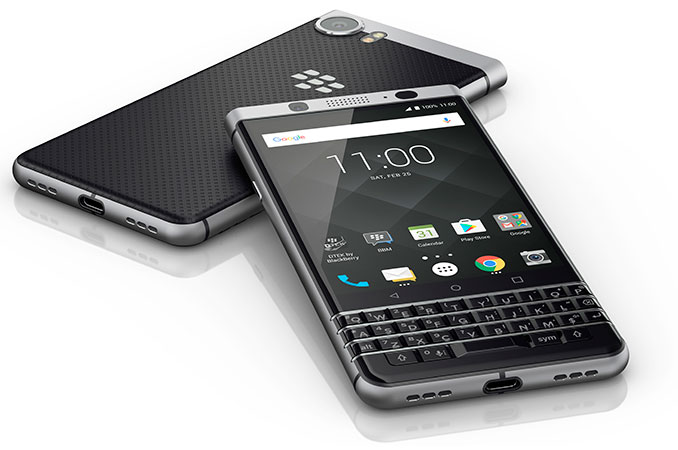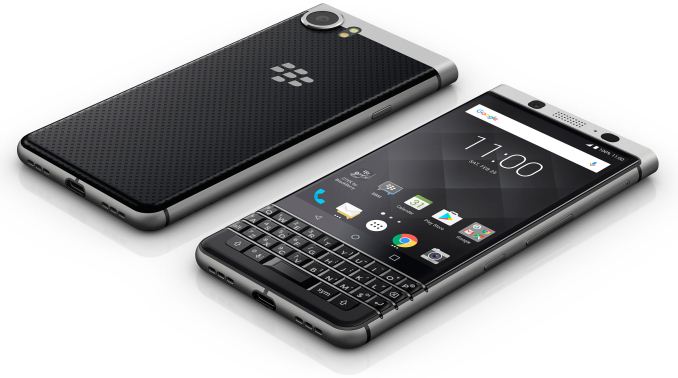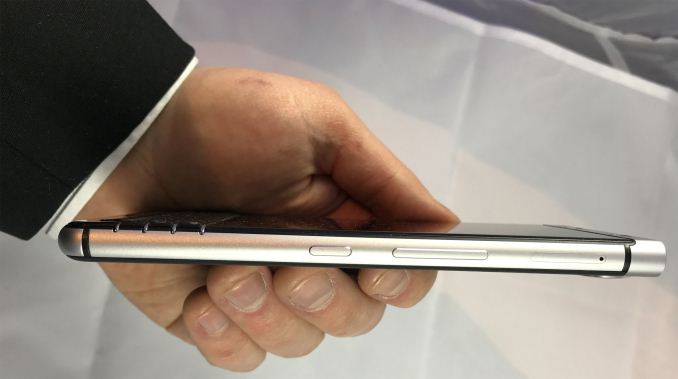BlackBerry KEYOne Announced: Snapdragon 625 with QWERTY, $549
by Anton Shilov on February 27, 2017 9:00 AM EST- Posted in
- Smartphones
- Android
- BlackBerry
- QWERTY
- Trade Shows
- MWC_2017
- KEYone

This week at MWC, TCL announced the BlackBerry KEYOne, which follows in BlackBerry's traditional style with a distinctive hardware QWERTY keyboard, but this time a more polished look at an Android implementation. The KEYOne implements a high-capacity battery, Qualcomm’s Snapdragon 625 SoC, Android 7.1, a 4.5” LCD display, and a USB-C connector for power and data. The KEYone will arrive in April at around $549.
Last year BlackBerry Limited announced its intention to quit from the development and the manufacturing of smartphones, deciding to focus on creating and licensing its brand, other IP, and primarily its secure software suite for mobile devices. TCL became the primary licensee of BlackBerry and this is a company that will produce BlackBerry-branded devices going forward. TCL is currently the only global licensee of the trademark, so this KEYOne is the first BlackBerry-branded device, aiming at similar markets to BlackBerry's previous products.
The KEYone is not the first BlackBerry-branded handset from TCL (the TCL-developed DTEK50 device released in 2016 essentially uses the same platform as the Alcatel Idol 4 handset), but this if the first one that was developed to be a BlackBerry from the ground up and used a close collaboration with BlackBerry Limited for the design. So, while the KEYone is produced by TCL, engineers from BBL have added their touch to the product. In addition, the phone comes with pre-loaded software from BlackBerry, including the BlackBerry DTEK application that monitor’s phones security.
One of the product messages surrounding the launch was that when BBL and TCL started development of the KEYone, they set themselves a number of goals they wanted to achieve: keep the BlackBerry heritage, offer fast connectivity over today’s networks, ensure a long battery life, snappy multitasking performance, and make the device sturdy, yet stylish. We're sure that the sales numbers wil be the marker for how well they succeed.
First off, the quintessential value add for BlackBerry users has always been the physical keyboard, so this stays. TCL decided to add functionality to the keyboard beyond just typing, which is why the keyboard becomes an extension to the display as it supports swiping and programmable shortcuts. TCL lists that this functionality is useful for scrolling, photo editing, and opening apps (with various gestures).
Battery life is a major concern of virtually all smartphone users. To make the KEYone last as long as possible, TCL did two things: it installed a ~3500 mAh battery into the handset and also picked up the Qualcomm Snapdragon 625 SoC. The S625 is an SoC we're going to see a lot of in 2017, as an alternative to S652 phones: rather than using 2xA72/4xA53 on 28nm, the S625 offers 8xA53 but on Samsung's 14nm LPP process, so while the latter might actually be lower in peak performance, the smaller node and lower power cores enable significant battery life improvements. On the connectivity side of things, the Snapdragon 625 supports 802.11ac, Bluetooth 4.2 and integrates Qualcomm’s X9 LTE modem (Cat 7 LTE, up to 300 Mbit/s downlink and up to 150 Mb/s uplink).
| BlackBerry KEYone Specifications | |
| SoC | Qualcomm Snapdragon 625 (MSM8953) 8x ARM Cortex-A53 @ 2.0 GHz Adreno 506 |
| RAM | 3 GB LPDDR3 |
| Storage | 32 GB (eMMC) |
| Display | 4.5-inch 1620x1080 (434 ppi) with Gorilla Glass 4 |
| Network | 3G: WCDMA (DB-DCHSDPA, DC-HSUPA), TD-SCDMA, EV-DO, CDMA1x 2G: GSM/EDGE 4G: depends on the version Canada, LATAM, APAC, US V1: EMEA: US V2: |
| LTE | Down: 300 Mb/s Up: 150 Mb/s |
| Audio | Stereo speakers 3.5-mm TRRS audio jack |
| Dimensions | see pictures |
| Rear Camera | 12 MP with f/2.0 aperture and dual LED flash |
| Front Camera | 8 MP |
| Battery | 3505 mAh with Qualcomm's FastCharging 3.0 |
| OS | Android 7.1 |
| Connectivity | 802.11ac Wi-Fi, Bluetooth 4.1, USB-C |
| Sensors | Fingerprint, accelerometer, gyroscope, magnetometer, proximity, ambient light |
| Navigation | GPS, GLONASS (?) |
| SIM Size | NanoSIM |
| Colors | Black/Metallic |
| Launch Country | NA, EMEA (parts), APAC(?) |
| Price | $549/€599/£499 |
The BlackBerry look is distinctive. There are virtually no phones with a keyboard today, and given the more modern design (compared to say, the Passport), this handset should stand out for more positive reasons. The keyboard uses stainless-steel strips between the rows for touch-type assistance and to aid the look. Since part of KEYone’s front panel is occupied by its QWERTY keyboard, the IPS display of the smartphone has a 3:2 aspect ratio in its 1620x1080 resolution, which is unusual for a smartphone.
The KEYOne has a rather unique texture to the back of the device (the material TCL uses for the back side is unknown), which looks like processed leather or carbon fiber, but which is designed to be both sturdy and oleophobic. Moreover, this coating is designed to prevent the phone from slipping from hand during usage. As for the overall feel, the KEYone feels very solid, but its thickness is 0.37”, which is considerably thicker than that of most modern smartphones of comparable dimensions (Apple’s iPhone 7 is 0.28”, the iPhone 7 Plus is 0.29”). Part of this is down to the battery.
When it comes to imaging, the BlackBerry KEYone uses Sony’s Exmor IMX378 and dual-tone flash as its primary camera as well as an 8 MP sensor (with selfie flash via LCD) on the front. Given the fact that the KEYOne is primarily targeting business users, nothing extra special was needed here.
As for pricing and availability, the BlackBerry KEYone will hit the market in April in multiple countries at $549/€599/£499 price points. It's going to be interesting to see how many octo-A53 devices ever reach that price point.
Source: BlackBerry Mobile














49 Comments
View All Comments
AmazonJohn75 - Monday, February 27, 2017 - link
See what I mean. Blah, hurry up April.philehidiot - Tuesday, February 28, 2017 - link
Something about this processor seems off... 8 cores all the same speed? Can anything generate 8 decent threads to actually make use of this? I'd have thought if you're going to use the A53s on a 14nm process and not use any high speed cores then you might as well just have 4? Is Android capable of the thread management required to utilise 8 cores properly?piroroadkill - Tuesday, February 28, 2017 - link
Just stop what you're doing, BlackBerry. Make a landscape slider QWERTY with decent mid-range specs and a good price point, make the bootloader unlockable and sell a boatload of them.HomeworldFound - Tuesday, February 28, 2017 - link
This vs the new Nokia 3310Texax - Wednesday, March 1, 2017 - link
I can tell a lot of people are not familiar with newer BlackBerry PKBs so let me try to clarify how it works.1) Blackberry hardware keyboard is powered by Swift keyboard which means over the time it will predict your vocabulary and will offer you relevant suggestion, it also predicts words as you start typing and it will give you three suggestions and if one of them is correct you just swipe up with your finger over hardware keyboard to accept it, no need for finger travel and tap on suggestion. It also allows you to type in multiple languages at once which is very neat.
2) Hardware keyboard is not just for typing its for commands and shortcuts as well. For example you can press and hold H to start navigation to your home address, or you can press and hold any key to call someone directly. Hold and press T for Torchlight LED. Or hold N for new text. Hold space bar to record the voice. This behavior depends heavily on operating system and while BB10 had all of those function they could go only so far on Android. Android doesn't recognize PKB in its SDK which is a shame really so all the work you see on KEYone is done by Blackberry developers and I am not sure if other app developers will be able to integrate KEYone keyboard as shortcuts within the app. For example in Facebook messenger you could tap F to find friends or N to go to News, etc instead of hunting these options all over the header or sliding context menu.
3) There is a concern if hardware keyboard takes away from the screen or not. Well that all depends on OS really. First of all when software keyboard shows up it actually takes a lot more of the screen estate to accommodate the size of the key due to lack of physical separation between the keys than hardware keyboard. Software keyboard relies on sight while hardware keyboard relies on touch for usage. When software keyboard is retracted there is a lot more screen estate for content but hardware keyboard has functionality that saves you finger travel as well as multiple required taps to get you to the action you want to. There is benefit to both and that solely depends what operating system wants to be. BB10 was optimized for text input and textual communication, that's why its devices had 1:1 screen ratio cause width was more important than height, it is also a lot lighter on headers and footers within the apps so they don't take limited screen space. Android is media consumption oriented environment and like that it prefers tall narrow screen so more graphical content could be fed on single screen. Reason why KEYone looks kind of weird is that unproportional tallness it exhibits on top of the keyboard. I understand they wanted one hand use but in my honest opinion Android would benefit a lot more from wide portrait screen device with two hand hardware keyboard so all text, sheets, slides mobile users could fit their documents comfortably over the screen. Sheets look horrible on 16:9 devices in portrait mode and so do Slides and even Text.
Bob Todd - Wednesday, March 1, 2017 - link
It's good to see that after a decade of fail worthy of a case study for business school, Blackberry's main licensee is continuing the tradition. What a joke.Itselectric - Wednesday, March 8, 2017 - link
All BlackBerry had to do was integrate with Android as soon as it started gaining traction, keep the hardware tailored for their niche, add their own software specific features and they would have been financially booming. Instead, they decided to keep their BB OS which had little third party support and rarely update the hardware, which is what led to their downfall in the manufacturing side of mobile devices.Pessimism - Monday, March 6, 2017 - link
$550 for a china-phone with a dead company's logo on it? pass.trumanhw - Saturday, March 11, 2017 - link
The phone looks like a quality build -- with a USB 3.1 CONNECTION! Hello, this means that you're not limited to THIRTY MEGABYTES per second.PHYSICAL, TOP NOTCH, BENCHMARK, GOLD STANDARD of Smartphone keyboards. NO!?
What is WRONG with all the negative winers!?? WTF?
8-core, 14nm generation SoC. This should give great battery life.
Higher PPI than iPhone, no??
Blackberry security!? No??
BBM Messaging
HALF THE PRICE OF THE iPhone? Is expensive?
We ALL win if the product is good -- because that's what makes the products we get, better.
Just get the thing in your hand, use it for a month or two and then say what you think of it.
I'm' horny for a damned QWERTY keyboard.